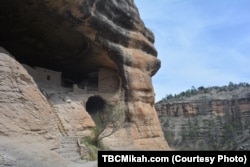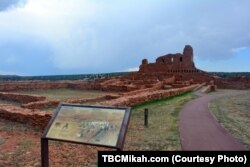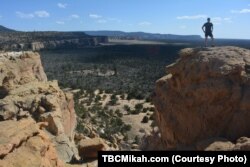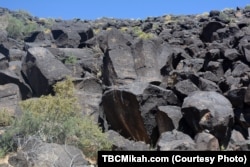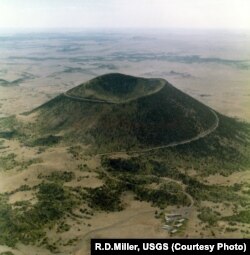As national parks traveler Mikah Meyer continued his travels through the southwestern state of New Mexico, he was exposed to more otherworldly swaths of natural -- and man-made -- beauty. Its nickname, after all, is the Land of Enchantment. New Mexico is a large state, with 15 national park sites. While many of them share the same geography and landscape, each has its own distinct personality, Mikah said.
Cliff Dwellings
At the Gila Cliff Dwellings National Monument, located deep within the Gila forest, he walked among the ruins of homes that belonged to the region’s indigenous peoples a thousand years ago... residences that had been painstakingly carved out of the natural caves, with breathtaking views of the surrounding land and nearby Gila River.
“What makes them so unique to all the other cliff dwellings in the park system are that the public is actually allowed to walk up into these caves,” he said. “So compared to most of the cliff dwellings in the park system this offers a unique chance that most don’t.”
Salinas Pueblo Missions National Monument
Heading northeast from the ancient cliffs, Mikah made a quick stop at Salinas Pueblo Missions National Monument -- one of many Spanish missions in the American southwest that was meant to bring Christianity and Spanish culture to the native people.
“This site has three different ruins,” Mikah noted, “adobe brick structures that have survived since the era of the Spanish arrival to the Pueblo culture.”
“One of them, the church, was so well intact that just from speaking, I could tell the acoustics were amazing,” he said, adding that it was no surprise that concerts are held there on a regular basis.
El Malpais National Monument
Other wonders awaited Mikah at El Malpais National Monument, known for its massive sandstone bluffs. The giant rocks “appear to burst out of the ground,” he noted.
“It’s such a unique climbing experience,” Mikah said. “You can climb on these massive boulders, and jump from boulder to boulder… you feel like a five-year-old again, discovering a new land!”
Ancient messages
Petroglyph National Monument near Albuquerque is home to thousands of stone drawings that were carved onto volcanic rocks by Native Americans and Spanish settlers 400 to 700 years ago.
The images are considered a valuable record of cultural expression which hold profound spiritual significance for contemporary Native Americans and for the descendants of the early Spanish settlers, according to the National Park Service.
But what they mean is still unclear.
“There are so many faces and shapes and animals that nobody really knows what they were used for,” Mikah explained. “If it was a sacred location, if it was a historical notation system for the natives… nobody really knows.”
What is known is that modern homes and neighborhoods have been built within sight of the ancient rocks, one of the largest petroglyph sites in North America.
“The development was coming so close to this old native history area that that's really what encouraged the local community to try to protect it,” Mikah said.
A mini Grand Canyon
Close to New Mexico's capital city of Santa Fe is Bandelier National Monument, which Mikah described as a mini Grand Canyon...
“It's in a valley between two very stark, tall canyon walls,” he said. But with a slight difference.
“As you look at the canyons, there's all these holes which were little dwellings,” he said. “People lived in these eroded or carved out areas in the canyon walls, or in some areas you’ll see they build stone houses outside of it.”
“It's this combination of natural beauty and stunning canyon walls with early historical homes and culture and it's just a really nice mix of beautiful landscapes and historical information.”
Born of fire
The entire state of New Mexico has mountains just about everywhere, Mikah noted, but the northeastern region is home to a lot of old volcanoes. He enjoyed exploring one of them at the Capulin Volcano National Monument, which protects the now-dormant Capulin cinder cone volcano, part of an extinct volcanic field.
Visitors can actually climb down into the belly of this once-active natural wonder, one of the few places in the world that offers this opportunity.
Stepping over the ancient lava rocks inside the bowl-shaped crater, Mikah said he could only imagine the power of the volcano's massive eruption roughly 56,000 to 62,000 years ago.
Back at the top, Mikah enjoyed a picturesque walk along the rim of the volcano, which provided a “really amazing 360-degree views of the area.”
“It's just a very different landscape from the rest of New Mexico in that the ground is covered in grass,” he said. “So you’ve got little rolling hills that were formed by lava flow or other volcanoes, and then this light green dry grass on top of them and then these really intense green bushes and trees.”
The park grounds are also home to many species of birds and animals such as Mule deer, elk, black bears, coyotes, and even the occasional mountain lion.
Mikah looks forward to visiting New Mexico’s remaining national park site wonders and invites you to follow along on his website, Facebook and Instagram.
